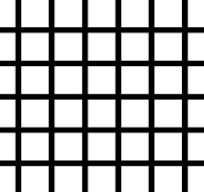Unveiling the Enigmatic World of Grid Illusions
The Fascinating World of Grid Illusions
Grid illusions, also known as Hermann grid illusions, are a captivating visual phenomenon that plays tricks on our perception. These illusions involve a grid pattern of black squares on a white background with light-coloured spots at the intersections. When you focus on the grid, you may notice ghost-like grey blobs appearing at the intersections where there are no actual spots.
This intriguing effect is caused by the way our eyes and brain process visual information. The Hermann grid illusion exploits the way our visual system perceives contrast and edges within a complex pattern. The brain tries to make sense of the conflicting information it receives from the grid, leading to the perception of illusory grey blobs.
Grid illusions are not only visually captivating but also offer valuable insights into how our brains interpret visual stimuli. By studying these illusions, researchers can gain a better understanding of human perception and cognition.
Next time you come across a grid illusion, take a moment to appreciate the complexity of your visual system and how easily it can be deceived by simple patterns. Grid illusions remind us that what we see is not always an accurate representation of reality, highlighting the fascinating intricacies of human vision.
Understanding the Hermann Grid Illusion: Mechanisms, Dots, Avoidance, and Psychological Insights
- How does the grid illusion work?
- What are the dots in the grid illusion?
- How to avoid Hermann Grid illusion?
- What is the Hermann grid illusion in psychology?
How does the grid illusion work?
The grid illusion, also known as the Hermann grid illusion, works by exploiting the way our visual system processes contrast and edges within a complex pattern. When we focus on a grid pattern of black squares on a white background with light-coloured spots at the intersections, our brain tries to make sense of the conflicting information it receives. This leads to the perception of illusory grey blobs at the intersections where there are no actual spots. The phenomenon showcases how our eyes and brain interact to interpret visual stimuli, offering a fascinating insight into the complexities of human perception and cognition.
What are the dots in the grid illusion?
In the grid illusion, the dots that appear at the intersections of the black squares are known as light-coloured spots. These spots play a crucial role in creating the visual phenomenon that tricks our perception. Despite their appearance, there are actually no physical dots present in those locations. Instead, the brain interprets the contrast and edges of the grid pattern in a way that generates the illusion of dots where there are none. This intriguing aspect of grid illusions demonstrates how our visual system can be easily manipulated, leading to fascinating optical effects that challenge our understanding of reality.
How to avoid Hermann Grid illusion?
To avoid experiencing the Hermann Grid illusion, one effective approach is to shift your focus away from the intersections of the grid. By directing your gaze towards the individual squares rather than the points where they meet, you can reduce the likelihood of perceiving the illusory grey blobs. Additionally, adjusting the lighting conditions in which you view the grid, such as increasing ambient lighting or changing the angle of illumination, may help diminish the strength of the illusion. Experimenting with different viewing distances and angles can also provide insights into how perception is influenced by visual cues.
What is the Hermann grid illusion in psychology?
The Hermann grid illusion in psychology is a well-known visual phenomenon that demonstrates how our perception can be influenced by the arrangement of visual elements. In this illusion, a grid of black squares on a white background with light spots at the intersections creates the perception of grey blobs at the empty intersections. This effect occurs due to the way our brain processes contrast and edges in complex patterns, leading to the perception of illusory grey patches where there are none. Studying the Hermann grid illusion provides valuable insights into how our visual system interprets information and highlights the intricate workings of human perception and cognition.


